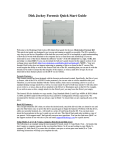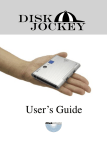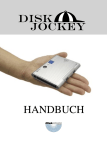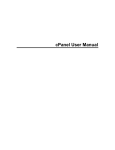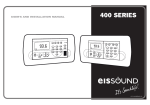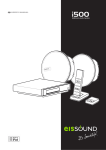Download Diskology Disk Jockey User`s guide
Transcript
Disk Jockey Quick Start Guide Welcome to the Diskology Disk Jockey (DJ) Quick Start guide for the new, ultra-portable, compact Disk Jockey! This quick start guide was designed to get you up and running as quickly as possible. The DJ is actually a pretty simple device. Regardless of the task that you want your DJ to accomplish, a quick understanding of how the DJ works both attached to the computer and as a stand alone unit should do the trick for you. If you are interested in more of the theory behind the different “modes” of the DJ (mount drives, mirror, span, copy, verify, test and erase x1, erase x3) you can download the full user’s guide located in the support section of our webpage (more specifically http://www.diskology.com/DiskJockeyUserGuide.pdf). The concept behind the DJ is that you select the mode that you want to use, attach the drive(s) that you intend to use and press the blue button once to power the drives up and again to begin the function. That’s it! Problems with the drives, cables not securely fastened, etc., will result in a series of loud beeps from the DJ. You can learn more about the beep patterns in the user’s guide on our web site. This Quick Start guide also includes a copy of our generic “tech support email” that typically answers most questions. You can also find more Q&A’s at the support section of our web site or you can email [email protected] for a quick answer. Using Modes 3, 4, 5, 6 & 7 (copy, compare, disk check and disk erase) Let us take you through an example using the most popular DJ mode, mode 3, or Copy Mode. Note – All modes that don’t require a computer operate in the way described below. So if you are looking to copy (Mode 3), compare (4), disk check (5) or erase data via either a one-pass or three-pass erase mode (6 or 7) the following instructions will help you complete the task. Step 1: Using the small screwdriver switch the DJ to Mode 3 (or 4, 5, 6 or 7 depending on desired results) on the Mode Switch dial. Step 2: Attach the drive that you wish to copy data from (source) to port 1 of the DJ. There is an arrow showing data copy flow on the DJ as well. Step 3: Attach the drive that you wish to copy to (target) to port 2 of the DJ. Step 4: Hook up the power to the DJ (and plug it into the wall while you’re at it!) Step 5: Press the Blue power button on the DJ one time. You should hear the drives start spinning up. Step 6: After waiting a few seconds (typically no more than 5-10 seconds) press the Blue power button again, the copy process should begin. Step 7: Go surf the web, answer some email, etc. The progress of the copy can be deciphered using the LEDs per the notes in the manual, but you can typically count on a copy of about 2 GB/min (actually a little less). So if you are copying a 40 GB drive, the entire process should take between 18-20 minutes. When the copy is complete the DJ will automatically power down the drives and shut off. NOTE – If you run into a problem with the DJ and need to power the unit down, hold down the Blue power button for approximately 10 seconds and you will hear the drives spin down and the power turn off. Using Modes 0, 1 and 2 (standard, mirror and span / combine) Mode 0 (mounting drives as standard desktop storage via USB or firewire), 1 (mirroring) and 2 (combine / spanning) require that the DJ is hooked up to the computer via the included USB or firewire cable. Mode 0 will make the drive(s) attached to the DJ accessible as typical desktop storage, no need for an enclosure. Mode 1 (mirroring) will present one drive icon on your desktop. Data copied to the icon will be copied to both drives attached to the DJ simultaneously for an instant backup. Mode 2 (combine / spanning) will combine the drive sizes of two drives attached to the DJ to appear as one logical volume to the DJ (ex: 80 GB and 240 GB = one 320 GB drive). Support Help / Troubleshooting The DJ is relatively support-free (sure, they all say that, right?), no really! This document began as a sort of “autoresponse” to people emailing us with support questions. We now have over 3,000 DJ’s in the field and have been able to solve most problems with just a few simple explanations. Quite frankly, if one of these items doesn’t solve your problem, your unit may simply be defective, and if that’s the case we’ll send you a new one within your warranty period or work with you to repair your unit after that time. So here goes, just a couple of items that may make you think "of course I'm doing that!" but trust me, about 75% of our support inquiries are from some simple oversights. The Disk Jockey is actually a fairly simple tool; too simple at times so people try to out think it. :-) 1- When using the DJ for a copy, make sure that the source drive is hooked up to Port one of the DJ, target to port two. It is also essential to have the DJ powered down before changing modes or it will retain the functionality of the previously used mode (it ships on Mode 0). So, make sure the power is off and then change the mode switch to mode 3 for disk copy. 2- Also, make sure that the drive is fastened securely to the DJ connector. This is by far the way most DJ problems are solved. We typically suggest removing the drive from the cable and re-connecting with an emphasis on reattaching the drive securely. If you need longer cables they are available at the Diskology web site (www.diskology.com) or email us at [email protected]. 3- Remember, the DJ ONLY works with UDMA drives. While there is no magical watermark for what is and isn't UDMA, typically drives under 10 GB are not UDMA. Drives must also be jumpered as “master.” 4 – While we have your attention, unfortunately we have not been able to source a reliable SCSI adapter. We do, however, offer an inexpensive SATA adapter on the Diskology web site as well as longer cables. If you are still having trouble it's typically not a bad idea to put the DJ into mode 0 and see if you can access the source drive via USB or firewire. Has this DJ worked fine in the past or is this its first run around the block? Does it work with other drives? It’s a good idea to try and rule out the drives, cables, etc. before initiating a return. Our return rate is wonderful (less than 1%) but we have had a couple of dozen go belly up over the past 2 years. Same-sized Drives and Drive Size Differences Finally, one other thought for those with copy problems. Unfortunately not all similar sized drives are created equally. The DJ copies EVERY sector on a disk. So, if you have a 250 GB drive from Maxtor for example and let's say it formats out to 242.7 GB. Then you get a WD 250 GB drive and it formats out to 242.6 GB, you won't be able to copy the Maxtor to the WD because the Disk Jockey will notice right away that there are not enough formatted free sectors on the target drive. Then you'll get beeping. The other way would work fine, however. We typically recommend copying to a slightly larger drive. Check FAQ’s Please don’t forget to check the FAQ section on our web site if you’re still having troubles and please don’t hesitate to drop us a note at [email protected]. We’re getting pretty good at this Disk Jockey thing so chances are we’ve heard of your problem before and can work to quickly solve it. We hope that you enjoy the Disk Jockey! If you like your experience with the product we would love to put your comments on our website (and give you a little plug as well, our testimonials page gets several hundred hits per day). Just drop us a note at [email protected] And if you have any question, comments, suggestions or concerns please do not hesitate to contact us at either [email protected] or [email protected].


